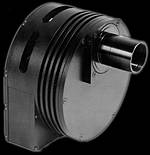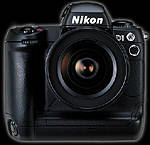| DarClean Afraid of the dark? |
Everything started last August, 2000.
 I've
been using digital cameras since 1992, mainly for astronomical photography. This
kind of photography needs loads of patience in order to capture the elusive and
tiny dots of light that come from the depths of space. Summer of 2000 was devoted
to test a new digital camera - a SBIG ST-7 - devoted to capture these tricky
subjects and to make some tests with a special color filter wheel to take
color images of galaxies and nebulae.
I've
been using digital cameras since 1992, mainly for astronomical photography. This
kind of photography needs loads of patience in order to capture the elusive and
tiny dots of light that come from the depths of space. Summer of 2000 was devoted
to test a new digital camera - a SBIG ST-7 - devoted to capture these tricky
subjects and to make some tests with a special color filter wheel to take
color images of galaxies and nebulae.
 At
the same time, the editor-in-chief of Reflex
(the Italian monthly magazine I'm working for as a contributing editor) lent me
a gorgeous Nikon D1 - one of the best digital reflex cameras on the market - along
with two lenses: a 17-35mm f/2,8 and an 80-200 f/2,8. Using this camera to shoot
astronomical subjects was a logical step: the first subject was the
Moon through my favourite telescope, an Astro-Physics
155mm Starfire EDF (equivalent to a 1162mm f/7.5 lens).
At
the same time, the editor-in-chief of Reflex
(the Italian monthly magazine I'm working for as a contributing editor) lent me
a gorgeous Nikon D1 - one of the best digital reflex cameras on the market - along
with two lenses: a 17-35mm f/2,8 and an 80-200 f/2,8. Using this camera to shoot
astronomical subjects was a logical step: the first subject was the
Moon through my favourite telescope, an Astro-Physics
155mm Starfire EDF (equivalent to a 1162mm f/7.5 lens).
Then, I tried to shoot some more difficult targets: a globular cluster and a planetary nebula. In both cases, I was disappointed to discover that the D1 "B" exposure is practically a fake: you need to keep your finger pressed all the time during the exposure. The manual exposure limit is 30 seconds, so I tried to raise the gain of the Nikon D1 changing its sensitivity from ISO 200 to ISO 1600. The result was discouraging: the thermal noise on the images was so high that the main subjects were almost unrecognizable.
 |
After 30 seconds, the Nikon D1 catches the light from the globular cluster M13 (left). There is a lot of thermal noise, though; the uper left corner of the image is brighter because the CCD is hotter there. On the right, the 6.5x enlargement shows an unacceptable amount of noise |
 |
But... Wait: I could try to reduce the noise just applying the techniques I learned when shooting astronomical subjects! In fact, every image shot through one of those specialized digital astro-cameras would need at least a traditional light exposure to catch the light of a deep-sky object. Then a dark exposure will follow: this is simply another image with the same exposure time with the cap on the telescope which will be subtracted via software to eliminate the thermal noise.
So, I put the cap on the telescope and I shot another image with the same exposure time of the photos I took to the globular cluster and the planetary nebula.
After having downloaded the images to a faithful Apple PowerBook G3/266, I opened them in Adobe Photoshop 5.5 and made a 10-second image processing...